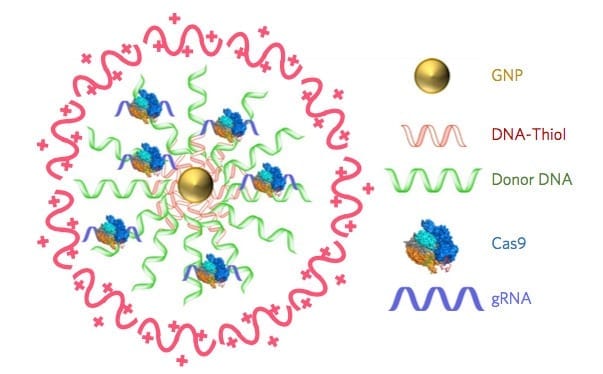
Duke University biomedical engineers have been able to repair a defect responsible for one of the most common inherited disorders, Duchenne muscular dystrophy
Using a novel genetic ‘editing’ technique, Duke University biomedical engineers have been able to repair a defect responsible for one of the most common inherited disorders, Duchenne muscular dystrophy, in cell samples from Duchenne patients.
Instead of the common gene therapy approach of adding new genetic material to “override” the faulty gene, the Duke scientists have developed a way to change the existing mutated gene responsible for the disorder into a normally functioning gene. The Duke researchers believe their approach could be safer and more stable than current methods of gene therapy.
The researchers are now conducting further tests of this new approach in animal models of the disease.
Duchenne muscular dystrophy is a genetic disease affecting one in 3,600 newborn males. The genetic mutation is found on the X chromosome, of which males have only one copy. (Females, with two X chromosomes, presumably have at least one good copy of the gene.)
Patients with Duchenne muscular dystrophy cannot produce the protein known as dystrophin, which is essential in maintaining the structural integrity of muscle fibers. Over time, patients with the disorder suffer gradual muscle deterioration, which leads to paralysis and eventual death, usually by age 25.
“Conventional genetic approaches to treating the disease involve adding normal genes to compensate for the mutated genes,” said Charles Gersbach, assistant professor of biomedical engineering at Duke’s Pratt School of Engineering and Department of Orthopaedic Surgery and member of Duke’s Institute for Genome Sciences and Policy. “However, this can cause other unforeseen problems, or the beneficial effect does not always last very long.
“Our approach actually repairs the faulty gene, which is a lot simpler,” said David Ousterout, the Duke biomedical engineering graduate student in the Gersbach lab who led the work. “It finds the faulty gene, and fixes it so it can start producing a functional protein again.”
The results of the Duke study were published online in Molecular Therapy, the journal of the American Society for Gene and Cell Therapy. The project was supported by the Hartwell Foundation, the March of Dimes Foundation and the National Institutes of Health.
The Duke experiments, which were carried out in cell samples from Duchenne muscular dystrophy patients, were made possible by using a new technology for building synthetic proteins known as transcription activator-like effector nucleases (TALENs), which are artificial enzymes that can be engineered to bind to and modify almost any gene sequence.
These TALENs bind to the defective gene, and can correct the mutation to create a normally functioning gene.
“There is currently no effective treatment for this disease,” Gersbach said. “Patients usually are in a wheelchair by the age of ten and many die in their late teens or early twenties.”
Duchenne muscular dystrophy has been extensively studied by scientists, and it is believed that more than 60 percent of patients with this type of mutation can be treated with this novel genetic approach.
The Latest Bing News on:
Duchenne muscular dystrophy
- Patients With DMD Receiving Eteplirsen Show Prolonged Survival, Study Findson April 25, 2024 at 2:03 pm
The study provides evidence of survival benefits among patients with Duchenne muscular dystrophy (DMD) receiving eteplirsen compared with the natural history of the condition.
- DeWine: Ohio first state in the nation to screen newborn babies for Duchenne Muscular Dystrophyon April 24, 2024 at 9:00 pm
Ohio Gov. Mike DeWine on Monday announced that Ohio will become the first state in the nation to begin screening all newborn babies for Duchenne Muscular Dystrophy. The provision was included in HR 33 ...
- Annual ‘Dining for Duchenne’s’ event a fundraising force in Pembertonon April 24, 2024 at 4:08 pm
Pemberton man Alexander McCormack and his family are determined to help find a cure for Duchenne’s Muscular Dystrophy ...
- Capricor Therapeutics Announces Positive Type-B Meeting with FDA for CAP-1002 Program for Duchenne Muscular Dystrophyon April 24, 2024 at 8:00 am
Company Aligned with FDA on Demonstration of Non-Clinical Comparability; Allowing for Immediate Use of San Diego Manufacturing Facility--FDA ...
- Ohio sets the trend in screening newborns for rare disease. What to know about DMDon April 24, 2024 at 3:58 am
Ohio Gov. Mike DeWine announced the state will be the first in the nation to screen newborns for the rare disease Duchenne Muscular Dystrophy.
- Glucocorticoid use can aid breathing ability in Duchenne adults: Studyon April 23, 2024 at 8:28 am
Glucocorticoid use was seen to help maintain breathing ability and arm function in adults in the late stages of Duchenne muscular dystrophy.
- Duchenne UK and Parent Project Muscular Dystrophy Award $500,000 to Evaluate Safety and Tolerability of Muscle Progenitor Cells in Phase 1 Trialon April 23, 2024 at 7:01 am
Parent Project Muscular Dystrophy (PPMD), a US nonprofit organization, and the UK charity Duchenne UK, two leading organizations dedicated to ending Duchenne muscular dystrophy (Duchenne), are excited ...
- My son's smile gives me hope for Duchenne muscular dystrophy. A new law could help otherson April 23, 2024 at 5:01 am
Opinion: Newborn testing can give families a head start on giving a child with the degenerative muscular disease a shot at the best outcome in life.
- Transitioning to adulthood with Duchenne muscular dystrophyon April 22, 2024 at 8:35 am
Transitioning to being an adult with Duchenne muscular dystrophy can involve changing doctors, more independent living, and going to college.
- An FDA pathway can accelerate innovation for Duchenne muscular dystrophyon April 22, 2024 at 1:31 am
Few treatments are available for people with Duchenne muscular dystrophy. The FDA's accelerated approval program can help change that.
The Latest Google Headlines on:
Duchenne muscular dystrophy
[google_news title=”” keyword=”Duchenne muscular dystrophy” num_posts=”10″ blurb_length=”0″ show_thumb=”left”]
The Latest Bing News on:
Transcription activator-like effector nucleases
- Allergic to Eggs? Not These Eggson December 20, 2023 at 4:13 pm
To make their safer egg, the scientists used an enzyme known as TALEN (transcription activator-like effector nuclease). It’s similar to CRISPR in that it snips and edits genetic code according to set ...
The Latest Google Headlines on:
Transcription activator-like effector nucleases
[google_news title=”” keyword=”transcription activator-like effector nucleases” num_posts=”10″ blurb_length=”0″ show_thumb=”left”]










